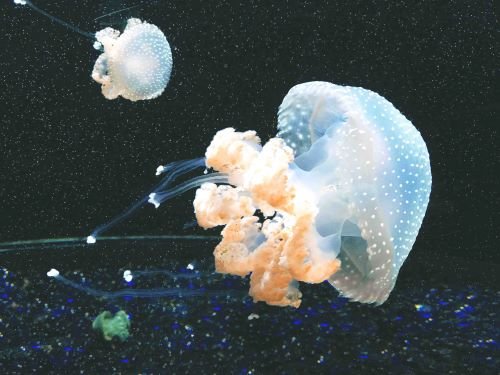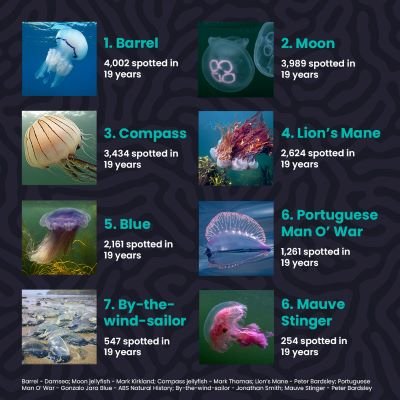
Marking 20 years of Wildlife Sightings
3 minute read
Today in 2023, as we celebrate 20 years of supporters reporting their jellyfish and turtle sightings to us, we take a look at how it all started, what we’ve learned and the difference your sightings have made.
The first jellyfish survey
Back in 2003, we set up the National Jellyfish Survey – the first and only jellyfish survey in the UK at the time.
The survey provides a baseline of data about jellyfish in UK and Irish waters, which can indicate change and be used for scientific studies. As well as jellyfish, we wanted to learn more about the leatherback turtle, which was a UK Biodiversity Action Plan species.
Leatherbacks come to UK and Irish waters in the summer to feed on our abundant jellyfish blooms, but are notoriously hard to spot.
So, we thought we could find out more about where they find their prey and feed around the UK by recording where and when the larger jellyfish occur in our seas. Our thinking was: find the jellyfish, find the turtles!

Credit: Joe Tillman
From posting out forms to posting online
In the early days, we created an ID guide and reporting form, which we posted out to anyone who was interested. We weren't sure how popular it would be, but just decided to give it a go and see!
The new programme got lots of interest from local and national media outlets. They often asked their readers or listeners to go jellyfish spotting in the summer, so we ended up sending and receiving thousands of forms!
In 2007, we decided to get with the times and go digital. Reporting since then has been done online, which is a lot easier – for our supporters and for us.
How the programme bloomed
The media promotion we received for our Wildlife Sightings programme helped it become what it is today.
223
marine turtles reported since 2003
18,357
total jellyfish sightings reported
We soon had not only hundreds of supporters reporting their sightings to us, but media outlets coming to us for our jellyfish expertise when writing articles about the animals.
Our scientists have featured on local and national radio stations and newspapers, and TV, including BBC, ITV and Channel 4 news, Countryfile, The One Show and the last ever Richard and Judy TV show!
From questions about what your sightings can tell us, to why huge blooms are washing up on our shores, and what to do if you get stung (do not pee on it!), our jellyfish experts have been answering every jellyfish query you can think of for the past twenty years.
Changes in our waters
A lot has changed since 2003, including the jellyfish we’re finding in our waters.

We’re seeing an increasing amount of jellyfish reports from the South West and Wales in recent years, suggesting that numbers are going up in these areas. We’ve also seen a definite rise in Portuguese Man O' War sightings, too.
Although we’re not fully certain on why this is happening, it may be linked to increasing sea temperatures as a result of climate change. Similarly, we tend to find more Portuguese Man O' Wars washing up on our shores during storm events, so an increase in the occurrence of these in recent years may be a reason for this.

Credit: Hansel Gonzalez
The science of jellyfish spotting
In 2013, we published our first paper on the jellyfish survey with the University of Exeter. This put jellyfish firmly back on the map - the last time UK jellyfish distributions had been mapped was in 1970.
We had the data analysed again in 2021 by the University of Plymouth and are currently working on a paper with them to publish the latest trends on jellyfish in the UK.
In November last year, we produced our first ever annual report on the Wildlife Sightings findings – an accessible, short summary of the jellyfish (and turtles) you spotted in UK and Irish waters.
It's been a pleasure developing the jellyfish survey and helping it grow from strength to strength. Through reporting their sightings, thousands of beachgoers have connected with and been fascinated by jellyfish and our amazing marine wildlife.
Peter Richardson, Head of Ocean Recovery

